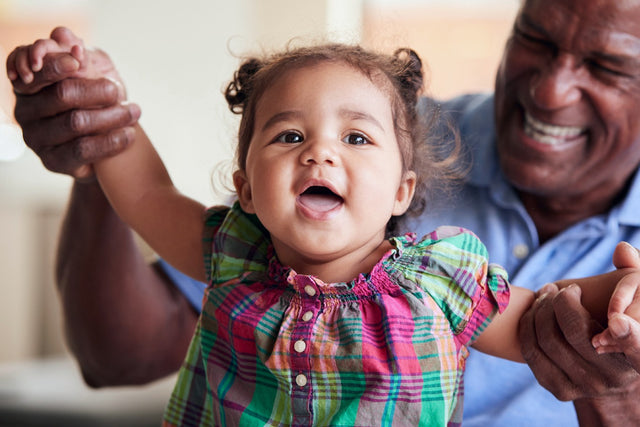13-Month-Old Baby Milestones

At 13 months, your toddler is a completely different person than the tiny newborn you helped through the 4th trimester.
Of course, a big part of the fun is watching for those first wobbly steps and simple words! You’ll also enjoy spotting new milestones like turning pages of a book, standing up and sitting down with control, and stacking items. These tiny steps are great leaps in terms of the brain’s increasing ability to control and coordinate the body’s many bones and muscles.
But dead ahead is another big leap! No longer a mushy little infant, your tot is now a member of the family with their own emotions, desires, and opinions. But, unfortunately, they’re not yet one who follows the family rules. In fact, they can be downright uncivilized!
Your 13-Month-Old’s Development
In Happiest Baby on the Block, we teach that babies need a “4th trimester” of loving attention. In key ways, they’re like fetuses born three to four months too early. In Happiest Toddler, we teach that they best way to understand toddlers (8 months to 5 years) is not as little children, but as little “cave kids!” Toddlers are wonderful, happy-go-lucky little creatures who spit and scratch and throw things and are still fine with pooping in their pants. The next few years, your job will be to gradually civilize your little cave buddy. Tots need our patient help as they learn social rules, like saying “please” and “thank you” or waiting their turn and sharing toys.
Communicating With Your 13-Month-Old
Toddlers are pretty good at making their opinions known. Your child may already use a few words, but the way they really get their point across is with nonverbal communication. That means, through pointing, laughing, yelling, even using some simple sign language signs!
As mentioned last week, your child’s more emotional right half of the brain (the center for recognizing faces, dancing, singing, and non-verbal language) develops many months ahead of their more adult left brain (the center for words patience, cooperation, etc.) In truth, when we’re upset, we all dial down our left brains and get less eloquent, less patient and we use more non-verbal communication: our voice and faces get more animated and emphatic.
The same is true for what we understand. Both toddlers and adults become pretty bad listeners when we’re upset. That’s why tots don’t do well if we acknowledge their feelings using long sentences and a voice that is too calm. (You might want to refresh your memory about the Fast-Food Rule).
That’s where speaking to them in their own primitive language, aka Toddler-ese, can save the day. You can translate anything you want to say into Toddler-ese with these three easy steps:
- Use short phrases: Instead of “I know you feel mad about it,” try “You’re mad!”
- Use repetition: Repeat the phrases three to eight times so it really gets through. (“You’re mad! Mad, mad, MAD! You say, ‘No, no, no!’”)
- Let your tone and gestures mirror one-third of your child’s upset: Tots understand body language better than words…especially when they’re unhappy! So, aim to reflect about one-third of your child’s intensity with your words and gestures.
Adults use Toddler-ese when we’re in a country where we don’t speak the language. In that case, we use pointing and face gestures and emphatically say the one or two words we know in that language (“Gracias! Gracias!”) to try to make our point. Parents also use Toddler-ese when kids are happy! (“Mmmm, mmmm…that is yummy, yummy, huh?”).
Play at 13 Months
After the first birthday, tots love practicing their arm and hand coordination. They experiment with moving their wrists to dump, mix, shake, throw…and use a spoon. Increasingly they enjoy dump trucks, push-along doll strollers, kickballs, splashing water, pouring sand, and more.
That said, research suggests that having a pick of fewer toys is better for children’s focus, creativity, and development: A 2017 study found that tots with four toys had higher “quality of play” than those with 16. So put a few toys out and rotate them on a regular basis with others that are hidden in the closet! (Be a little sneaky with this and don’t let your child see you taking them out of the closet. If they see there is a toy store of interesting things in the closet, they may start demanding the whole bunch.)
Do 13-Month-Olds Need Shoes?
Before your little one’s first steps, you could probably get away with little to no shoes. That changes now! As you start to shop, you’ll want to factor in your child’s development as well as the shoe’s style. Here’s what the American Academy of Pediatrics says to keep in mind:
- Allow your child to remain barefoot at home to allow their feet to naturally develop (as long as your home is not too cold).
- Get lightweight and flexible shoes. Soft leather and mesh shoes are good options that are breathable and support natural foot movement.
- Get shoes with rubber soles that grab….don’t slide. Your baby is just learning to walk … you don’t want their shoes flying out from under them!
< Your 12-Month-Old Baby | Your 14-Month-Old Baby >
View more posts tagged, milestones
Have questions about a Happiest Baby product? Our consultants would be happy to help! Submit your questions here.